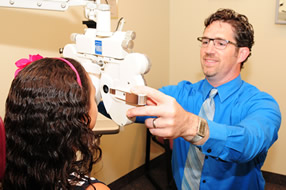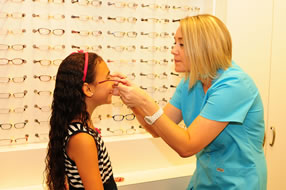 Myopia
Myopia
Myopia, or nearsightedness, is a refractive error, which occurs when the shape of the eye does not bend light correctly, causing blurred vision. Myopia, also known as nearsightedness, is when a person can see items that are close, but objects in the distance appear blurry. This condition is inherited and usually discovered during childhood. As a person ages, myopia can progress and worsen, requiring a stronger prescription to correct the person’s vision.
Myopia is a common focusing disorder, not an eye disease. In fact, approximately 25% of Americans have myopia. If you experience blurred vision, please contact us for a complete eye examination. Myopia is most commonly treated with corrective lenses, whether it is eyeglasses or contact lenses.
Find out more about Myopia.
 Presbyopia
Presbyopia
In a younger eye, the eye works similar to a camera “zooming in and out” to focus on objects near and far. As the eye ages, this ability begins to decline. This inability to accommodate the focus of your eyes on objects from far to near is referred to as presbyopia, or farsightedness. Presbyopia is the aging of the lens in the eye, which can make reading and seeing things up close more difficult.
The cause of presbyopia is still unknown, but it is believed to occur because the lens of the eye progressively hardens as it ages. When this happens, it is more difficult for the lens to change its shape to increase its near focusing power.
Symptoms
Presbyopia reduces a person’s ability to see things up close, making things like reading difficult. If you begin to notice that you have to hold your book or newspaper further away than usual to clearly see the words, you may be suffering from presbyopia. This usually occurs in people over the age of 40. For those, who are already farsighted, presbyopia may occur in the mid-30s.
There are many treatments available for presbyopia, the most common being the use of reading glasses or bifocals. Surgical options can include LASIK or the use of intraocular lenses.
Find out more about Presbyopia.
Low Vision
If a person’s level of vision drops below normal, 20/70 or worse, this is known as low vision. Low vision is not blindness, but it is a level of vision that cannot be corrected with conventional glasses or contact lenses. Low vision can interfere with a person’s performance of daily activities, including reading, watching TV, driving or interacting with others.
Find out more about Low Vision.